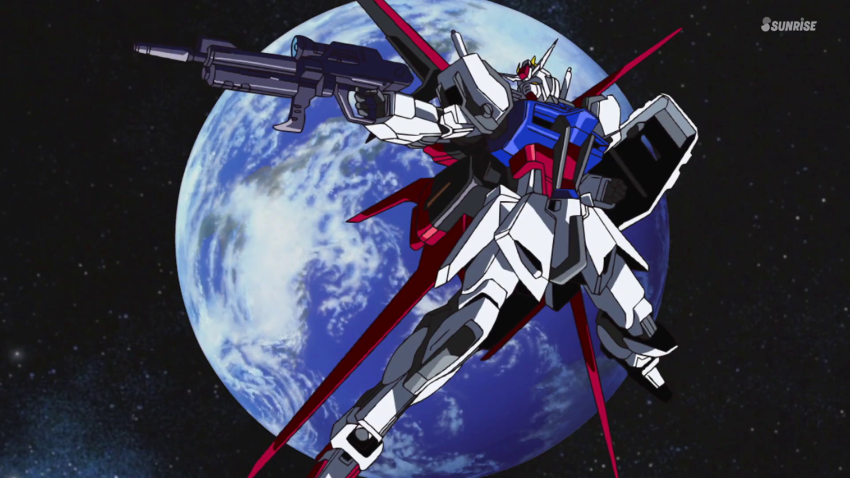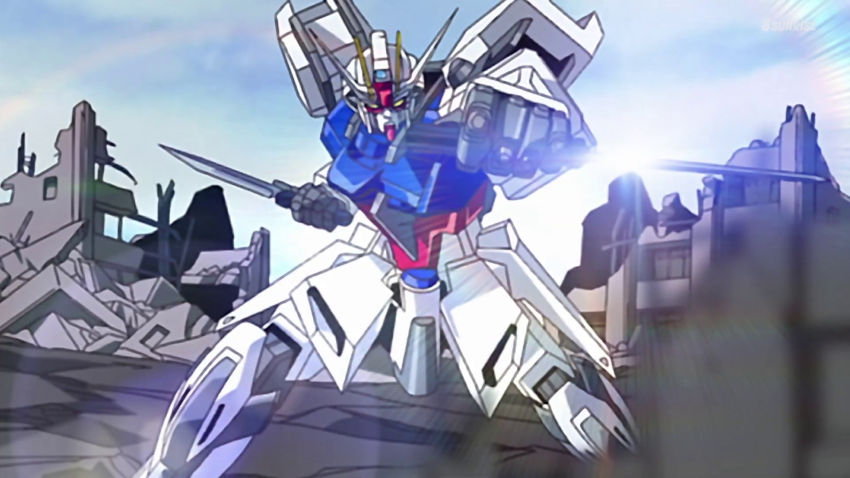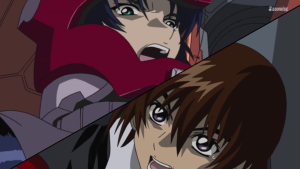Gundam Seed
August 31, 2020 · 0 comments
By Andrew Osmond.
 Broadcast in Japan from 2002, Gundam Seed was the first TV Gundam of the twenty-first century and yes, you can definitely start with it. A space adventure tailor-made for newcomers, Gundam Seed was a vital gateway Gundam for Western fans, second only to Gundam Wing. Seed is a “new” story in a new timeline, but it also sees Gundam return to its own franchise roots – namely, the very first Gundam series from 1979, available from Anime Limited.
Broadcast in Japan from 2002, Gundam Seed was the first TV Gundam of the twenty-first century and yes, you can definitely start with it. A space adventure tailor-made for newcomers, Gundam Seed was a vital gateway Gundam for Western fans, second only to Gundam Wing. Seed is a “new” story in a new timeline, but it also sees Gundam return to its own franchise roots – namely, the very first Gundam series from 1979, available from Anime Limited.
How much Gundam Seed returns to those roots is evident from the way the story starts. We’re in the future, and human conflict has spread to the stars. Earth is at war with a breakaway culture of space-dwelling people, known at the Coordinators. The action starts on a supposedly neutral space colony (the cylindrical kind proposed by Gerard K. O’Neill), which is secretly developing weapons for Earth. In retaliation, the Coordinators attack the colony; the operation’s wily commander is a man in a metal mask.
However, Seed focuses more on a group of young friends caught up in the attack. One of them, Kira Yamato, stumbles upon the factory housing the secret weapons – giant fighting robot vehicles, called Gundams. After Kira literally tumbles into one of the machines, the boy instinctively realises how it’s meant to work, and fights his first epic battle against the Coordinators. But there’s a catch – Kira is a Coordinator too.
You can look at Seed as doing for Gundam what J.J. Abrams would later do for Star Trek – going back to the first version of a venerable franchise, and retelling and retooling it for a new generation. In Japan, Seed was a palpable hit, which at one time occupied the top eight spots in the anime DVD charts. It won Animage’s “Grand Prix” award in 2002, the first Gundam to do so since the original series. Bandai also claimed that Seed drew in young and female viewers beyond Gundam’s traditional fanbase. After all, it was shown at 6pm – which led to minor controversy over a mild bed scene to amuse anyone who recalled a comparable hoo-ha over Evangelion.
Anyone who’s seen the 1979 Gundam won’t need to be told how many of its story details match Seed. True, when I covered Gundam Wing, I stressed how much that drew on the first series too, but Seed goes much further. I haven’t even mentioned how Seed’s action involves a sturdy Earth spaceship, crewed by inexperienced youngsters – it’s called the Archangel, but any old-school Gundam fan will take one look at it and think “White Base.” Seed also brings in Gundam’s old cute ball-robot Haro, which had sat out Wing and some other recent Gundam series. Seed even features the archetypal Gundam scene in which the main characters fight it out while plunging down into a planet’s atmosphere… although in Seed, there’s a tragic sting ending.
 Like Gundam Wing, Gundam Seed played on Western TV in the 2000s. In America, it was shown on the Cartoon Network, and on YTV in Canada. In Britain, it aired on the short-lived satellite channel AnimeCentral and it had a DVD release on the Beez label, deleted. Another link between Wing and Seed is that Japanese actor Toshihiko Seki, who voiced the pilot Duo Maxwell in Wing, returns in Seed to voice the masked Coordinator commander, called Rau Le Creuset. Older fans will take one look at the character’s metal mask and think, “Char’s back.” I talk about the practice of Char cloning in my Gundam Wing article.
Like Gundam Wing, Gundam Seed played on Western TV in the 2000s. In America, it was shown on the Cartoon Network, and on YTV in Canada. In Britain, it aired on the short-lived satellite channel AnimeCentral and it had a DVD release on the Beez label, deleted. Another link between Wing and Seed is that Japanese actor Toshihiko Seki, who voiced the pilot Duo Maxwell in Wing, returns in Seed to voice the masked Coordinator commander, called Rau Le Creuset. Older fans will take one look at the character’s metal mask and think, “Char’s back.” I talk about the practice of Char cloning in my Gundam Wing article.
Seed’s creators were a husband and wife team. Mitsuo Fukuda was the director, having working at Gundam’s studio Sunrise since 1979. He was especially linked with a Sunrise racing franchise of the 1990s, Future GPX Cyber Formula. His wife Chiaki Morosawa was Seed’s lead writer; she died in 2016, aged 56.
Of course, as Seed developed, Fukuda and Morosawa rang numerous changes on the Gundam template, some reflecting the times. For example, there’s a much more sprawling cast of characters than in the older Gundams. The expanded cast allows for complex subplots and dramatic conflicts, and also for many character figurines. An interesting gender swap involves the captain of the hero spaceship. In the first Gundam and its sequels, it was the male Bright Noa; Seed switches him out for two female officers on the bridge, who aren’t always in agreement.

Another re-permutation; in the first Gundam, the central conflict was always between the young hero Amuro Ray and the masked antihero Char. In Gundam Seed, the fight is between Kira and a Coordinator soldier, Athrun, who’s a boy who seems very like Kira. In fact, the boys used to be best friends, and they agonise over their duty to kill each other, while Le Creuset – Seed’s answer to Char – pulls their strings amusedly.
In this way, Gundam Seed seems to foreshadow a Sunrise mecha show made a few years later – Code Geass, with its central conflict between schoolfriends Lelouch and Suzaku. And if we’re talking Geass, you might take note of a girl character in Seed – we won’t spoil which one it is. At the start, this girl seems a minor character, only useful for putting into danger or acting as a love rival… until there’s a sudden tragedy, and the girl’s story becomes far more painful, twisted and fascinating. Code Geass fans might compare her to a supporting character in the later series, the one who practically vanished in the films.
Another important female debuts several episodes into Seed. She’s Lacus, a beautiful Coordinator girl who seems serenely unworldly and perhaps very dangerous, and who’s important to both Kira and Athrun. Lacus is a singer, an idol with a hypnotic voice; in Japanese, she was voiced and sung by Rie Tanaka, who played Chii in Chobits the same year. You could argue that Lacus has some of the unearthly presence of Lalah, a crucial character in the first Gundam… but it’s hard not to suspect she owes more to the rival Macross space-opera franchise, and its idol heroine Minmay. For creative Gundam–Macross crossovers, see my interview with Shoji Kawamori and my article on the Gundam anime Stardust Memory.
But perhaps the most important way that Seed differs from the 1979 Gundam is in the portrayal of its adversaries, the space-dwelling humans who fight Earth. In the first Gundam, the equivalent characters served an empire with Nazi overtones, down to their cries of “Sieg!” In Gundam Seed… Well, the details of the Coordinators, their history, and why they’re at war with Earth aren’t revealed until several hours into the series. We can say, though, that Seed goes full-throttle into the issue of human eugenics, a subject few Western TV shows would touch now.
Star Trek fans might remember the original ‘60s Trek referred to the Eugenics Wars which would happen in the “future” of the 1990s. To date, Trek has never actually shown the Eugenics Wars on screen. Let’s just say Gundam Seed shows what they might have been like…
Andrew Osmond is the author of 100 Animated Feature Films.
Gundam Seed is released in the UK by Anime Limited.
Leave a Reply